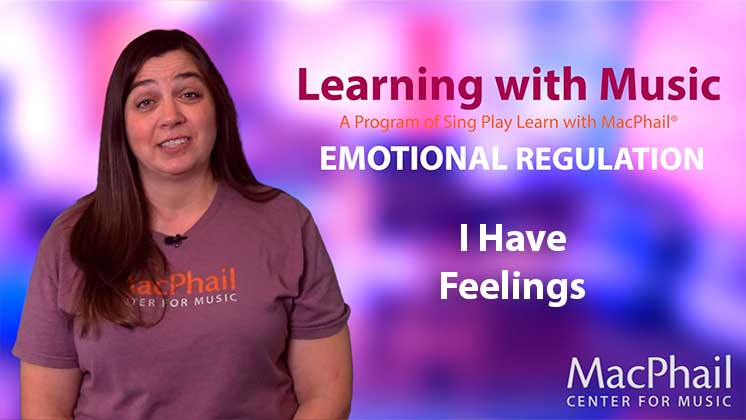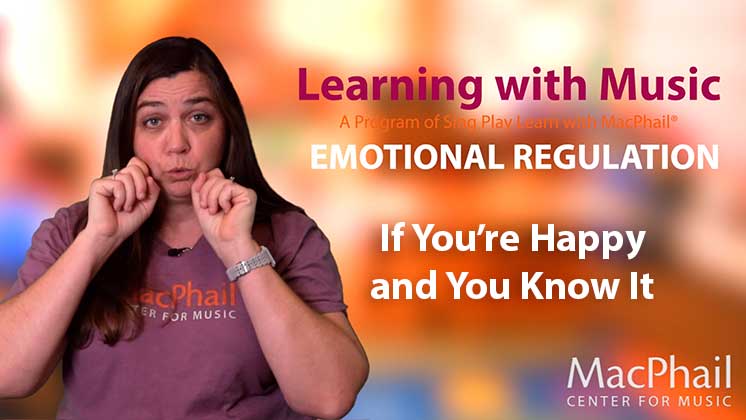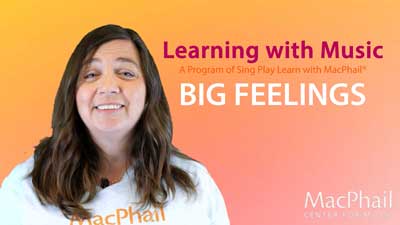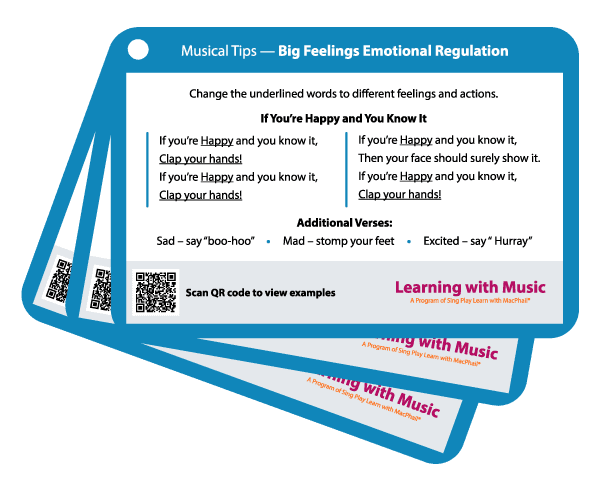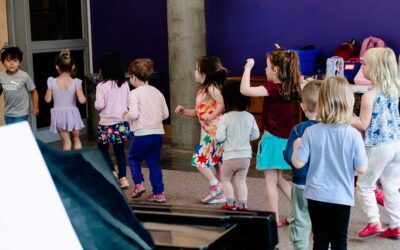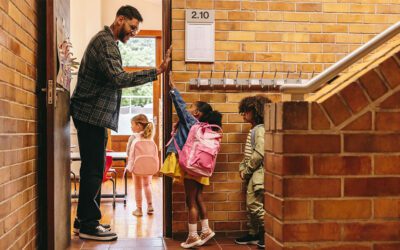Big Feelings: Music & Emotional Regulation
Age Level: 0 – 5 years
What is emotional regulation?
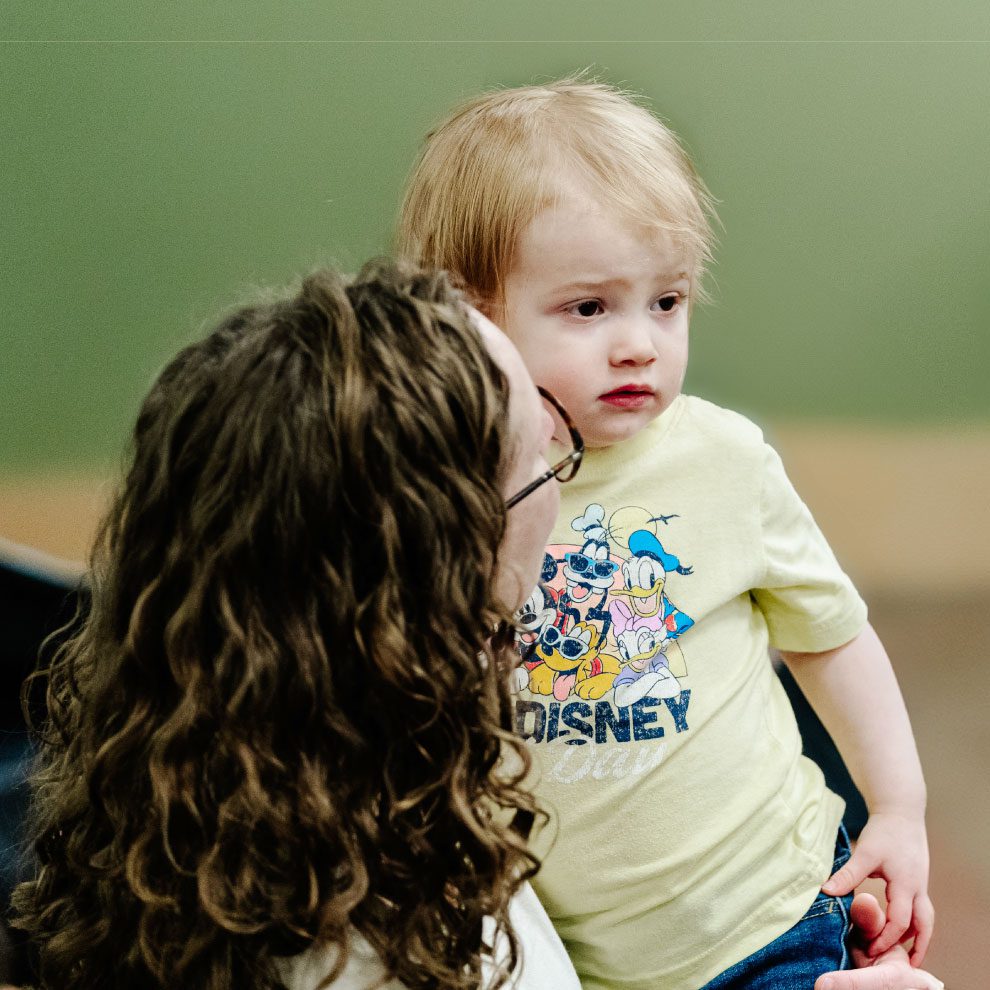
How does music help?
Music can help by creating a grounding or neutral avenue to regulate feelings. Singing with a child helps to refocus the child’s energy and create calm. Labeling and describing the emotions felt, and then singing about these feelings supports a child’s ability to reduce stress and cortisol levels. Singing can promote relaxation and reduce stress using long controlled breaths. Movement can slow down the body and help promote a reset to feelings.
Musical tips to promote emotional regulation:
I Have Feelings
If You’re Happy and You Know It
Additional Activities
I Have Feelings
I Have Feelings
(Sung to the tune of Twinkle, Twinkle)
- I have feelings so do you,
- Let’s all sing about a few.
- I am happy, I am sad,
- I am scared, I am mad
- I have feelings so do you.
- We just sang about a few.
If You’re Happy and You Know It
If You’re Happy and You Know It
- If you’re Happy and you know it,
- Clap your hands!
- If you’re Happy and you know it,
- Clap your hands!
- If you’re Happy and you know it,
- Then your face should surely show it.
- If you’re Happy and you know it,
- Clap your hands!
Additional Activities
For example: When the light moves up, breathe in. When the light moves down, breathe out.
Baby: Use a quiet voice and rock back and forth to music or while singing.
Breathe Like a Bear by Kira Willey. Watch a read-along video above and view the entire playlist of the book here.
Sing lullabies while rocking a child or having them rocking back and forth. Sing songs such as Twinkle, Twinkle, Rock-a-bye Baby, as well as the following:
I Have Feelings
(Sung to the tune of Twinkle, Twinkle)
- I have feelings so do you,
- Let’s all sing about a few.
- I am happy, I am sad,
- I am scared, I am mad
- I have feelings so do you.
- We just sang about a few.
Change the underlined words to different feelings and actions to act out:
If You’re Happy and You Know It
- If you’re Happy and you know it,
- Clap your hands!
- If you’re Happy and you know it,
- Clap your hands!
- If you’re Happy and you know it,
- Then your face should surely show it.
- If you’re Happy and you know it,
- Clap your hands!
Toddler or Preschooler: Teacher/Caregiver-dim the lights in their room and grab a flashlight. Turn on a quiet piece of music and slowly move the flashlight around on the ceiling. Ask the children to follow the light with their eyes. You can add breathwork to this.
For example: When the light moves up, breathe in. When the light moves down, breathe out.
Baby: Use a quiet voice and rock back and forth to music or while singing.
Breathe Like a Bear by Kira Willey. Watch a read-along video above and view the entire playlist of the book here.
Printable Resources
Flashcards provide rapid access to musical tips to help with transitions, daily routines, and big feelings. Flashcards can be worn on a lanyard so when a classroom challenge arises, you can scan a QR code to get quick support.
Tip Sheets complement flashcards by providing in-depth ideas to use music to support young children’s learning and development.
Flashcards provide rapid access to musical tips to help with transitions, daily routines, and big feelings. Flashcards can be worn on a lanyard so when a classroom challenge arises, you can scan a QR code to get quick support.
Tip Sheets complement flashcards by providing in-depth ideas to use music to support young children’s learning and development.
More Learning with Music:
Music & Transitions
Music & TransitionsAge Level: 0 - 5 yearsWhy are transitions important?Transitions can be a stressful part of a child’s day. Often transitions...
Daily Routines: Music for Welcoming the Day
Daily Routines: Music for Welcoming the DayAge Level: 0 - 5 yearsHow does music help to welcome the day?A musical start to the day is a positive and...


